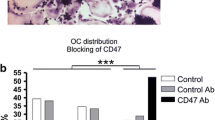Summary
The origin of osteoclasts was studied in embryonic rat bone primordia using a set of monoclonal antibodies (ED1, ED2, and ED3) that exclusively recognize monocytes and macrophages. ED1 recognizes monocytes and macrophages. Mononuclear phagocytes which were ED1 positive were found in the perichondrium/periosteum of developing bone. These cells started to infiltrate the primordia when the cartilage became hypertrophic. During bone formation, multinucleated ED1-positive cells with the morphological characteristics of osteoclasts were found in the developing bone marrow cavity and against the bone collar. The present findings support the notion that osteoclasts arise by fusion of mononuclear phagocytes derived from blood monocytes.
Similar content being viewed by others
References
Chambers TJ (1985) The pathobiology of the osteoclast. J Clin Pathol 38:241–252
Jotereau FV, Le Douarin NM (1978) The developmental relationship between osteocytes and osteoclasts; a study using the quail-chick nuclear marker in enchondral ossification. Dev Biol 63:253–265
Loutit JF, Nisbet NW (1982) The origin of osteoclasts. Immunobiol 161:193–203
Marks SC (1983) The origin of osteoclasts. J Pathol 12:226–256
Thesingh CW, Burger EH (1983) The role of mesenchyme in embryonic long bones as early deposition site for osteoclast progenitor cells. Dev Biol 95:429–438
Burger EH, Van der Meer JWM, Van de Gevel JS, Gribnau JC, Thesingh CW, Van Furth R (1982) In vitro formation of osteoclasts from long-term cultures of bone marrow mononuclear phagocytes. J Exp Med 136:1604–1614
Hume DA, Loutit JF, Gordon S (1984) The mononuclear phagocyte system of the mouse defined by immunohistochemical localization of antigen F4/80: macrophages of bone and associated connective tissue. J Cell Sci 66:189–194
Horton MA, Rimmer EF, Moore A, Chambers TJ (1985) On the origin of the osteoclast: the cell surface phenotype of rodent osteoclasts. Calcif Tissue Int 37:46–50
Nijweide PJ, Vrijheid-Lammers T, Mulder RJP, Blok J (1985) Cell surface antigens on osteoclasts and related cells in the quail studied with monoclonal antibodies. Histochemistry 83:315–324
Dijkstra CD, Döpp ED, Joling P, Kraal G (1985) The heterogeneity of mononuclear phagocytes in lymphoid organs: distinct macrophage subpopulations in the rat recognized by monoclonal antibodies ED1, ED2 and ED3. Immunology 54:589–599
Pearse, AGE (1968) Histochemistry. Theoretical and Applied, vol. 1, 3rd ed. Churchill Livingstone, Edinburgh
Author information
Authors and Affiliations
Rights and permissions
About this article
Cite this article
Sminia, T., Dijkstra, C.D. The origin of osteoclasts: An immunohistochemical study on macrophages and osteoclasts in embryonic rat bone. Calcif Tissue Int 39, 263–266 (1986). https://doi.org/10.1007/BF02555216
Received:
Revised:
Issue Date:
DOI: https://doi.org/10.1007/BF02555216




